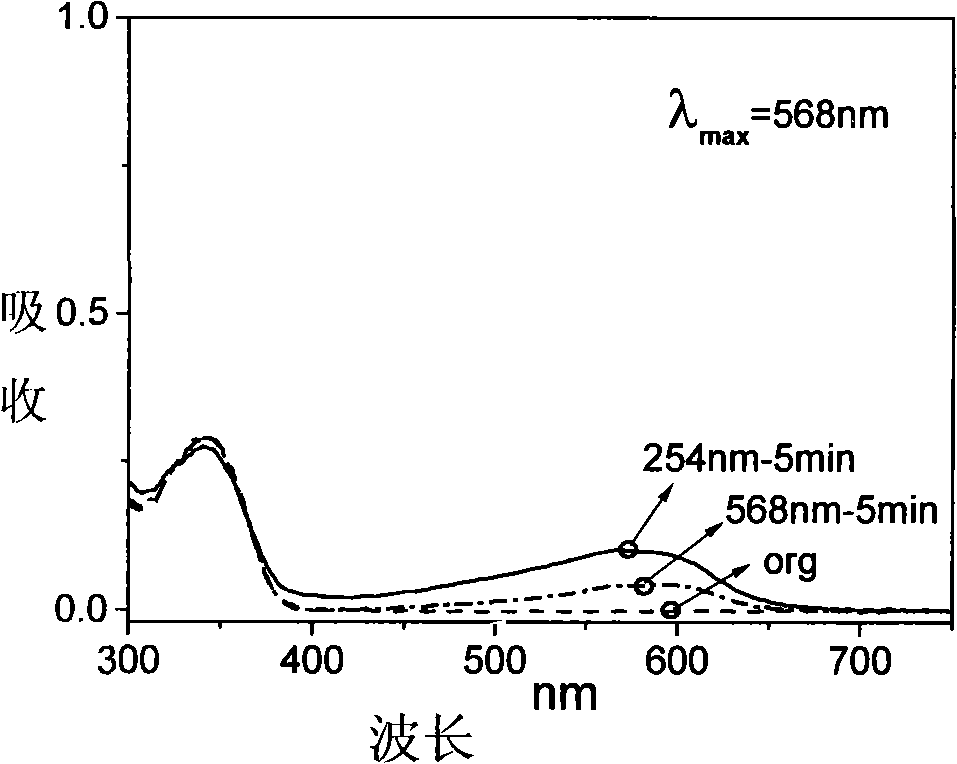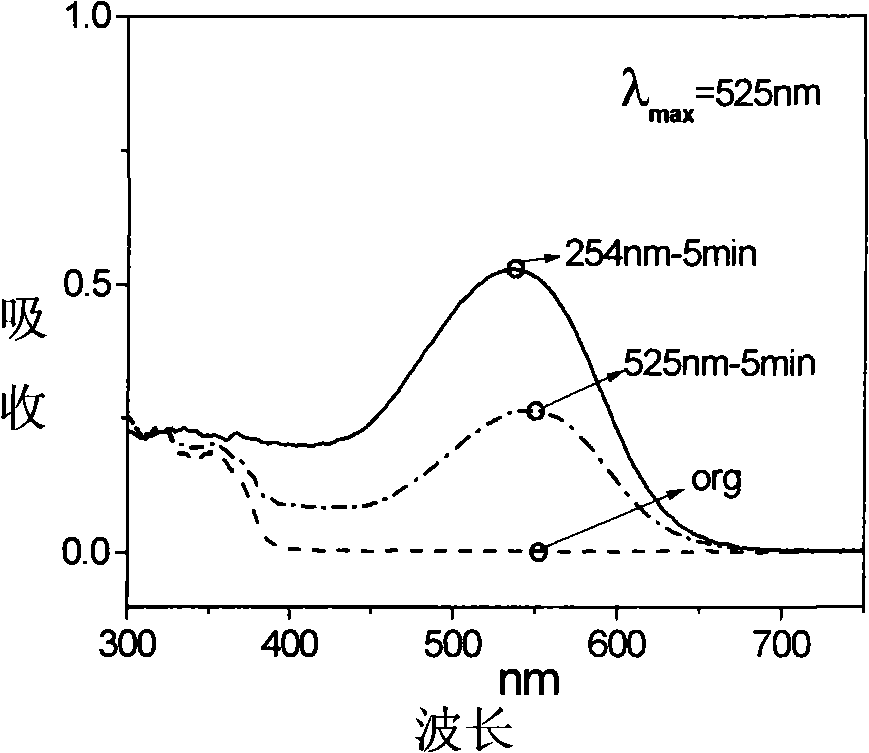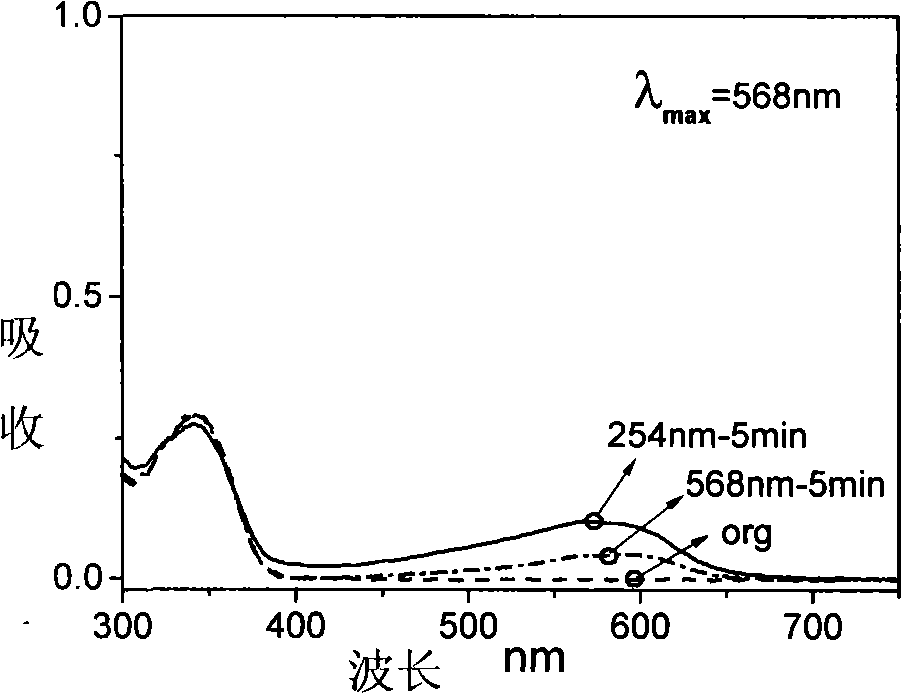Photo-acid polymer-doped spirooxazine or spiropyran reversible photochromic film, preparation method and use thereof
A photochromic and spirooxazine technology is applied in the field of material chemistry to achieve the effects of improving the ring-opening efficiency and photochemical reaction yield, stabilizing the ring-opening structure, and preventing oxidation side reactions.
- Summary
- Abstract
- Description
- Claims
- Application Information
AI Technical Summary
Problems solved by technology
Method used
Image
Examples
Embodiment 1
[0045]
[0046] 1. Take N-propionyl-benzospirooxazine (NSPO) as a sample, blend with polymer PVDC and polymethyl methacrylate (PMMA) at a mass ratio of 1:50, and dissolve them in tetrahydrofuran respectively, Preparation of NSPO 10 -3 mol / L tetrahydrofuran solution. The above two kinds of mixtures were used to prepare uniform and transparent NSPO-PVDC and NSPO-PMMA films on the quartz glass sheet by drop coating method.
[0047] 2. Measure the absorption spectra of NSPO-PVDC and NSPO-PMMA films before and after 254nm ultraviolet light irradiation (Hitachi UV-4100 ultraviolet-visible spectrometer).
[0048] 3. After being irradiated with 254nm ultraviolet light for 5 minutes, the maximum absorption peak of the NSPO-PVDC film was blue-shifted by 85nm compared with the NSPO-PMMA film, and the absorbance increased by 11 times. Such as figure 1 , as shown in 2.
[0049] 4. After irradiating with ultraviolet light, irradiate the NSPO-PMMA film with 610nm visible light (the sola...
Embodiment 2
[0053]
[0054] 1. Take 5-hydroxybenzospirooxazine (HSPO) as sample, blend with polymer PVDC and PMMA respectively with the mass ratio of 1: 50, be dissolved in tetrahydrofuran respectively, prepare the 10 of HSPO -3 mol / L tetrahydrofuran solution. A uniform and transparent film is prepared on a quartz glass plate by drop coating.
[0055] 2. Measure the absorption spectra of HSPO-PVDC and HSPO-PMMA before and after 254nm ultraviolet light irradiation.
[0056] 3. After being irradiated with 254nm ultraviolet light for 5 minutes, the maximum absorption peak of the HSPO-PVDC film was blue-shifted by 28nm compared with the NSPO-PMMA film, and the absorbance increased by 8 times. Such as image 3 , as shown in 4.
[0057] 4. After irradiating with ultraviolet light, irradiate the HSPO-PMMA film with 568nm visible light (the solar light source simulator passes through the 568nm filter) and irradiate the HSPO-PMMA film with 540nm visible light (the solar light source simulato...
Embodiment 3
[0061]
[0062] 1. Take N-propionyl-4-nitrospiropyran (NSPR) as a sample, blend it with polymer PVDC and PMMA respectively at a mass ratio of 1:50, and dissolve it in tetrahydrofuran respectively to prepare NSPR 10 -3 mol / L tetrahydrofuran solution. A uniform and transparent film is prepared on a quartz glass plate by drop coating.
[0063] 2. Measure the absorption spectra of NSPR-PVDC and NSPR-PMMA before and after 254nm ultraviolet light irradiation.
[0064] 3. After being irradiated with 254nm ultraviolet light for 5 minutes, the maximum absorption peak of the NSPR-PVDC film was blue-shifted by 120nm compared with the NSPR-PMMA film, and the absorbance doubled. Such as Figure 5 , as shown in 6.
[0065] 4. After irradiating with ultraviolet light, irradiate the NSPR-PMMA film with 562nm visible light (the solar light source simulator passes through the 562nm filter) and irradiate the NSPR with 422nm visible light (the solar light source simulator passes through the...
PUM
 Login to View More
Login to View More Abstract
Description
Claims
Application Information
 Login to View More
Login to View More - R&D
- Intellectual Property
- Life Sciences
- Materials
- Tech Scout
- Unparalleled Data Quality
- Higher Quality Content
- 60% Fewer Hallucinations
Browse by: Latest US Patents, China's latest patents, Technical Efficacy Thesaurus, Application Domain, Technology Topic, Popular Technical Reports.
© 2025 PatSnap. All rights reserved.Legal|Privacy policy|Modern Slavery Act Transparency Statement|Sitemap|About US| Contact US: help@patsnap.com



